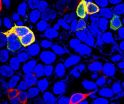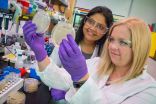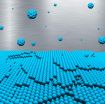(Press-News.org) BUFFALO, N.Y. – Empathy is among humanity's defining characteristics. Understanding another person's plight can inspire gentle emotions and encourage nurturing behaviors.
Yet under certain circumstances, feelings of warmth, tenderness and sympathy can in fact predict aggressive behaviors, according to a recent study by two University at Buffalo researchers.
But why?
That an expression of kindness might be manifest as a punch in the nose can leave observers scratching their heads.
The answer is that it's not about anger or feeling personally threatened, says Michael J. Poulin, whose study, "Empathy, Target Distress and Neurohormone Genes Interact to Predict Aggression for Others — Even Without Provocation," with Anneke E.K. Buffone, a graduate student in the UB Department of Psychology, was published in this month's edition of Personality and Social Psychology Bulletin.
Two neurohormones appear to be among the mechanisms contributing to the counterintuitive response. These are chemicals that act as both hormones in the blood stream and neurotransmitters in the brain.
"Both oxytocin and vasopressin seem to serve a function leading to increased 'approach behaviors,'" says Poulin, associate professor of psychology. "People are motivated by social approach or getting closer to others."
But Poulin adds that people approach one another for many reasons, including aggression, so it stands to reason that if compassion is linked to the action of these hormones and these hormones are linked to social approach behaviors that they might help account for the link between compassion and aggression.
The researchers conducted a two-part study consisting of a survey and an experiment. "The results of both indicate that the feelings we broadly call empathic concern, or compassion, can predict aggression on behalf of those in need," says Poulin.
The survey asked people to report on someone close to them and explain how that person was threatened by a third-party. Then, participants described their emotions and reaction to the situation.
"That wasn't surprising," says Poulin.
People aggressing on behalf of others has been widely researched, but Buffone and Poulin say "the idea that empathy can drive aggression absent of provocation or injustice is quite novel."
In the experiment, participants provided a saliva sample in order to measure neurohormone levels, then heard a compassion-evoking story about someone they never met, a fictional participant who was supposedly in another room with a second fictional participant. The actual participants were informed that the pair in the other room, strangers to each other, who were to take a math test, would be exposed to a painful but harmless stimulus (hot sauce) to measure the effects of physical pain on performance. During the test, the real subject had a choice on how much of a painful stimulus they would provide to the third party who was competing with the person they had compassion toward.
"The results of both the survey and the experiment indicate that the feelings we have when other people are in need, what we broadly call empathic concern or compassion, can predict aggression on behalf of those in need," says Poulin. "In situations where we care about someone very much, as humans, we were motivated to benefit them, but if there is someone else in the way, we may do things to harm that third party."
And that reaction is not because the third party has done anything wrong.
Consider parents who in order to benefit their child in competition might do something destructive to another challenger, Poulin says, or soldiers who in battle think more of protecting a comrade than fighting against a broader national threat.
Our study adds that our response is because of love or compassion for those we care about, he says.
INFORMATION:
"New Rochelle, NY, November 5, 2014—The e-incubator, an innovative miniature incubator that is compatible with magnetic resonance imaging (MRI), enables scientists to grow tissue-engineered constructs under controlled conditions and to study their growth and development in real-time without risk of contamination or damage. Offering the potential to test engineered tissues before human transplantation, increase the success rate of implantation, and accelerate the translation of tissue engineering methods from the lab to the clinic, the novel e-incubator is described ...
INDIANAPOLIS -- Indiana University School of Medicine researchers have identified a small protein with a big role in lowering plasma glucose and increasing insulin sensitivity. Their research appeared online today in Diabetes, the journal of the American Diabetes Association.
The report indicates that Sestrin 3 plays a critical role in regulating molecular pathways that control the production of glucose and insulin sensitivity in the liver, making it a logical target for drug development for type 2 diabetes and metabolic syndrome, which can produce increased blood pressure, ...
Researchers from Northeastern University's Marine Science Center and the University of North Carolina at Chapel Hill have found that moderate ocean acidification and warming can actually enhance the growth rate of one reef-building coral species. Only under extreme acidification and thermal conditions did calcification decline.
Their work, which was published Wednesday in the journal Proceedings of the Royal Society B: Biological Sciences, is the first to show that some corals may benefit from moderate ocean acidification.
Justin Ries, an associate professor ...
WASHINGTON, DC—November 4, 2014—An international team of bioengineers has boosted the ability of bacteria to produce isopentenol, a compound with desirable gasoline properties. The finding, published in mBio®, the online open-access journal of the American Society for Microbiology, is a significant step toward developing a bacterial strain that can yield industrial quantities of renewable bio-gasoline.
The metabolic engineering steps to produce short-chain alcohol solvents like isopentenol in the laboratory bacteria Escherichia coli have been worked on ...
From water marks to colored threads, governments are constantly adding new features to paper money to stay one step ahead of counterfeiters. Now a longhorn beetle has inspired yet another way to foil cash fraud, as well as to produce colorful, changing billboards and art displays. In the journal ACS Nano, researchers report a new kind of ink that mimics the beetle's color-shifting ability in a way that would be long-lasting and difficult to copy.
Zhongze Gu, Zhuoying Xie, Chunwei Yuan and colleagues explain that some U.S. bills have color-changing features to help thwart ...
Researchers from MIPT and the Weizmann Institute of Science (Israel) have predicted the possibility of negative turbophoresis, a phenomenon where impurity particles inside a turbulent flow move in an "impossible" direction. The study by Sergei Belan (a postgraduate at MIPT), Grigory Falkovich and Itzhak Fouxon was published in the journal Physical Review Letters in the Editors' Suggestions section, which features the most important and interesting studies from the editorial board's point of view.
The researchers studied the behavior of inertial particles in different ...
An international study has devised a new measure for the "livability" of major cities across the world. The Global Liveable Cities Index (GLCI) takes into account the sensibilities of ordinary working people from 64 cities, balancing work and play, environmental awareness, localism, globalism and many other factors. Details are published in the World Review of Science, Technology and Sustainable Development.
According to Tan Khee Giap of the National University of Singapore and colleagues at University of California, Davis, and Curtin University, in Bentley, Australia, ...
In a recent paper published in Nature Nanotechnology, Joel Moser and ICFO colleagues of the NanoOptoMechanics research group led by Prof. Adrian Bachtold, together with Marc Dykman (Michigan University), report on an experiment in which a carbon nanotube mechanical resonator exhibits quality factors of up to 5 million, 30 times better than the best quality factors measured in nanotubes to date.
Imagine that the host of a dinner party tries to get his guests' attention by giving a single tap of his oyster spoon on his crystal glass. Now, imagine, to the amazement of all, ...
New Danish-led research suggests that signs of brain aging can be postponed in mice if placed on a high-fat diet. In the long term, this opens the possibility of treatment of children suffering from premature aging and patients with Alzheimer's and Parkinson's disease. The research project is headed by the Center for Healthy Aging, University of Copenhagen and the National Institute of Health.
When we get older, defects begin to develop in our nervous system, our brain loses some of its intellectual capacity, and the risk of developing diseases such as Parkinson's and ...
Using DESY's ultrabright X-ray source PETRA III, researchers have observed in real-time how football-shaped carbon molecules arrange themselves into ultra-smooth layers. Together with theoretical simulations, the investigation reveals the fundamentals of this growth process for the first time in detail, as the team around Sebastian Bommel (DESY and Humboldt Universität zu Berlin) and Nicola Kleppmann (Technische Universität Berlin) reports in the scientific journal Nature Communications. This knowledge will eventually enable scientists to tailor nanostructures ...







